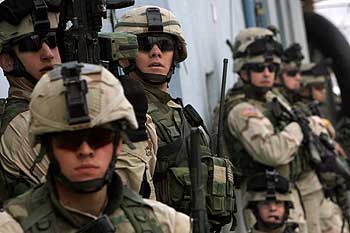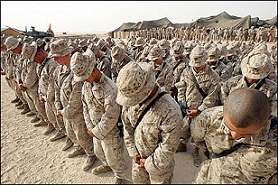The United States is planning to escalate its military presence in the Gulf after it withdraws its remaining forces from Iraq by year end.
The United States is planning to escalate its military presence in the Gulf after it withdraws its remaining forces from Iraq by year end. US Officials and diplomats have indicated that the actions could include the repositioning of its military forces in Kuwait so that it would be able to respond to any “security collapse” in Iraq or a “military confrontation” with Iran.
The New York Times published a report Saturday explaining that US President Barack Obama’s alternative to the US presence in Iraq would be a US military presence in Kuwait.
“With an eye on the threat of a belligerent Iran, the administration is also seeking to expand military ties with the six nations in the Gulf Cooperation Council — Saudi Arabia, Kuwait, Bahrain, Qatar, the United Arab Emirates and Oman. While the United States has close bilateral military relationships with each, the administration and the military are trying to foster a new security architecture for the Persian Gulf that would integrate air and naval patrols and missile defense,” NY Times’s report explained.
Quoting US Central Command’s Chief of Staff, Major General Karl R. Horst, the paper said that “the command is focusing on smaller but highly capable deployments and training partnerships with regional militaries... we are kind of thinking of going back to the way it was before we had a “big boots on the ground” presence… I think it is healthy. I think it is efficient. I think it is practical.”
Horst further explained that the training exercises that the “US is executing were a sign of commitment to presence, a sign of commitment of resources, and a sign of commitment in building partner capability and partner capacity.”
In parallel, Central Command’s Chief for Exercises Colonel John G. Worman noted that “for the first time, the military of Iraq had been invited to participate in a regional exercise in Jordan next year, called Eager Lion 12, built around the threat of guerrilla warfare and terrorism.”
According to the paper, a sample from the new US post-Iraq strategy that involves strong collaboration with the Gulf Cooperation Council, is Qatar and the United Arab Emirates’ sending of military forces to Libya as part of the NATO’s intervention there, in addition to the fact that each of Bahrain and the United Arab Emirates have forces in Afghanistan.
Another sample is the sending of Saudi forces into Bahrain to assist the government in suppressing the public demonstrations.
This repositioning strategy comes out after US Secretary of State Hillary Clinton has announced during her presence in Tajikistan last week that the US will have continuing robust presence in the region, warning Iran against any intervention in Iraq after the US forces’ withdrawal.
